A DECADE IN, ANDREA DOUGLAS SAYS THE JEFFERSON SCHOOL AFRICAN AMERICAN HERITAGE CENTER CONTINUES TO HONOR THE PAST—AND CHALLENGE THE FUTURE

JUST GETTING
All about town.
SPRING 2023 BOOK
| SHARING LIQUID GOLD | CREATIVE EXPRESSIONS
FESTIVAL PICKS
STARTED








2 434 Give the gift of clean. Miele’s HomeCare series is fully customizable for all types of homes — allowing you to choose the best accessories and floor tools to meet your needs. Visit us today and we will configure the perfect vacuum especially for you. 1327 E. High St. &296-8131 8cssvac.com Monday — Friday, 8:00am-5:30pm CHARLOTTESVILLE SANITARY SUPPLY CORPORATION 296-8131 www.cssvac.com 296-8131 www.cssvac.com 8:00 am - 5:00 pm Pediatric Associates of Charlottesville PLC Office Hours By Appointment Evening & Weekends until 9pm Urgent Care Available One of Our Physicians On Call After Hours Onsite Lactation Consultant Downtown Office & | 296-9161 Adolescent Center | 971-9611 1011 E. Jefferson St West Office 2411 Ivy Rd | 296-8300 North Office 29N at Hollymead (1522 Insurance Lane, A) | 974-9600 ZION CROSSROADS OFFICE 71 Jefferson Court off I-64 Exit 136 I 540-406-4100 CharlottesvillePeds.com Open 365 Days A Year until 9pm Comprehensive care from infancy to young adulthood

CLASSES FOR AGES 3+ ALL LAW ENFORCEMENT TRAINS ABSOLUTELY FREE 1646 Seminole Trail • Charlottesville, VA • 434.688.4482 info@graciecharlottesville.com graciecharlottesville.com THE AREA’S PREMIER BRAZILIAN JIU-JITSU SELF-DEFENSE ACADEMY VOTED BEST MARTIAL ARTS SCHOOL TWO YEARS IN A ROW!




FOR A GOOD DAY, CALL... Marijean Oldham. Page 30
On the cover: Executive Director Andrea Douglas says the Jefferson School African American Heritage Center connects the institution's history to the modern space. Photo: Eze Amos

6 434
12 PASSENGER TRANSIT LIMOUSINE





The Transit Limousine has all the luxury you have come to expect from a standard limousine, but with enough room for everyone. This is the perfect vehicle to enjoy Charlottesville’s many wineries and breweries with friends and family.



47–55 PASSENGER MOTOR COACH
The Motor Coach is the largest vehicle type in our fleet. We have two sizes of Motor Coach, 47 Passenger and 55 Passenger, both of which are ideal for large groups. These vehicles enable you to transport a significant number of passengers at one time

25 PASSENGER MINI BUS
Our Mini Buses are great vehicles for medium sized groups. These 25 Passenger vehicles, with their large viewing windows and individual seating, are a great way to tour the local area or shuttle guests from one location to another.

434 7
Call Us at: (434) 973-5466 (888) 725-5466 (LIMO) www.ambassadorlimos.com
RUNNER UP TRANSPORTATION
What separates Jordan from others:
- Cville native, alumnus of M. Lewis, Henley, WAHS, JMU
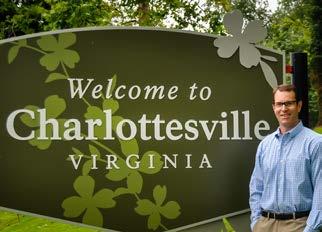
- Over $16M in annual sales






- Ranked in top 20 out of over 1,000 realtors
Seller Review: Jordan sold our home quickly and helped us select the best offer out of the 8 we received in one weekend on the market. He was wonderful and insightful in what was an extremely stressful event. His ability to market our home was impressive. It never looked better in the pictures he took. The 3D touring technology he used was amazing. Highly recommend Jordan. - Ben and Tracy

8 434 Tuel Jewelers On The Downtown Mall, 319 East Main St., Charlottesville "Your Friendly Jewelry Store since 1945" 434-295-4258 Tueljewelers@aol.com The more things change... the more they stay the same Diamond and Wedding Rings - College and High School Class Rings Pewter items - Accutron, Bulova & Caravelle Watches, Expert Watch and Jewelry Repair And much more. 1% Listing Commission. Full Service Real Estate. Service, Results and Personal Touch. Charlottesville native, Jordan Hague, is the owner and broker of Equity Saver USA which offers sellers and buyers of real estate a low cost alternative with no compromise in services or results. Interview Jordan before hiring anyone else. Ever seen what your real estate agent takes from you? Keep more of what’s yours with our 1% business model for buyers and sellers of real estate. For more information: www.EquitySaverUSA.com An Old Dominion Realty & Investment LLC company Full Service real eState. 1% commiSSion We Pay buyer cloSing coStS!
- Owner and Broker
Angie’s List Service Award Winner
Financial supporter of area non-profits IN CHARLOTTESVILLE CELEBRATING 15 EquitySaverUSA.com • 434-964-SAVE (7283) Instagram: @EquitySaverUSA Saved over $6,000 Saved over $6,000 Saved over $8,000 Saved over $5,000 Get Your Free Property Valuation Today! Call to learn how much you can save. on stands now There’s no place like home. Inside. Outside. Home. Changing the profile RESCUE, REUSE An historic log cabin gets second chance PAST IN PRESENT Kenny Ball’s three-decade career in antiques A fly kid’s room puts guests on an enviable top bunk While his colleague expanded vertically, an Alloy Workshop co-owner reimagined his first floor The funky-cool collaboration Abby Kasonik and Kiki Slaughter— what bright idea!
-
-
The ART of not doing MAINTENANCE
shelves. Friends saw them and laughed. The art started conversations, and maybe an argument or two. The friends commissioned a few pieces—like two clay cat toppers for a couples’ wedding cake.
Everyone was having fun.
Brown launched Strange Clay Creations to try his hand at selling his sculptures. So far, that’s been a good time as well, with some reservations. He has an Etsy store—though the logistics are a drag—and he’s done an art fair—though the high demand left him spent and lacking inspiration. The best outlet, he says, has been through C’ville Arts Cooperative Gallery, where he’s also been inspired by the other creatives in residence.
Some people don’t get Brown’s work. “What’s the point?” the killjoys ask. “For you, they do nothing,” Brown quips. But he’s made some practical pieces—ornaments and magnets and the like.
Brown started Strange Clay Creations with no formal art training, but working on his own motorcycles over the years likely helped him hone his handiwork. And he’s always been creative by nature.
“Maybe ’90s Nickelodeon TV warped my brain—growing up with those strange cartoons like ‘Ren & Stimpy’ and ‘Rocko’s Modern Life,’” he says. “I never cared about school as much as art and music.”
Fortunately for his psyche, Brown’s moved on from his job as a professional mechanic. His new gig as a media producer isn’t a bummer, but he’s not ready to give up what’s become his after-work outlet.
“I’ve been at it for three to four years, and the first one looked like a 2-year-old did it,” Brown says. “Now it’s definitely more refined and polished, and I like where it’s going. As long as I like making them and seeing other people’s reactions, that’s enough.”
DEREK BROWN’S SCULPTURE is all about fun.
The Palmyra resident started making quirky clay figures because he wasn’t having fun at his day job. He wants people to see his pieces and think, “That’s fun.” And if he stops having fun making the tchotchkes, he’ll give it up.

“Basically, I hated my job so much—being a mechanic—I needed something sort of comedic or less serious when I got off work,” he says.
Brown and his girlfriend got into clay together, learning to fashion figures on the fly. They made whatever came to mind. For Brown, it was odd, moody little cartoons, offbeat animals, various chonkies, cutesy utensils, and a dervish of devils and demons.
He stuck with it. He started in polymer clay and improved quickly. He branched into other materials. He finished and painted some pieces he was proud of. He put them on his
434 9 Metro CLAY DAY
Shea Gibbs
“Maybe ’90s Nickelodeon TV warped my brain—growing up with those strange cartoons like ‘Ren & Stimpy’ and ‘Rocko’s Modern Life.’ I never cared about school as much as art and music.”
DEREK BROWN
TRISTAN WILLIAMS
NOW HEAR THIS Listen UP
PODCASTS ARE THE fastest-growing audio entertainment platform in the country, according to the Radio Agency—more than one-third of Americans listen to them regularly. Charlottesville is home to some of the most engaging, from lighthearted chats to compelling true crime investigations. Give these five a stream.—Laura Drummond
“Bold Dominion” “Bold Dominion” covers all things Virginia state politics in succinct snippets. This podcast is a member of the Virginia Audio Collective and produced by WTJU 91.1 FM, the nonprofit radio station at UVA. Knowledgeable host Nathan Moore, WTJU’s general manager, keeps you informed of the most relevant topics impacting our commonwealth, like affordable housing, broadband expansion, abortion access, and right-wing extremism. Airing twice a month, episodes are thoughtful and educational.
“Green Light with Chris Long” Hosted by retired NFL star and UVA football titan Chris Long and his best friend Macon Gunter, “Green Light” is a sports podcast and then some. Rated one of the Top 10 football podcasts by Apple, it offers expert NFL and football analysis through recurring segments with Stanford Steve and Mina Kimes. It also tackles all sorts of other topics—entertainment, parenting, history, politics—nothing is off limits. Long has interviewed the likes of actor Matthew McConaughey, retired NASCAR driver Dale Earnhardt, Jr., and Buffalo Bills tight end Dawson Knox. Most episodes extend beyond an hour, making them perfect listening for long commutes.
“Small Town Big Crime” Focusing on turning up new leads in unsolved cases, this true-crime podcast is hosted by Charlottesville journalists Courteney Stuart and Rachel Ryan. Listen to the complete first season about the 1985 murders of Derek and Nancy Haysom in Bedford County and the subsequent conviction of their daughter and her boyfriend, Jens Soering. This podcast spans an extensive three-year investigation in easily consumable 30-minute episodes. Plans are in the works to cover other cold cases.
“Speaking in Hues” Produced at the UVA Maxine Platzer Lynn Women’s Center, this podcast discusses the experiences of Black women living and working in Charlottesville. It’s hosted by friends and colleagues Taylor Nichols, diversity, equity & inclusion expert and self-described pop culture queen, and Jaronda Miller-Bryant, scholar, mother of two, and self-described vegan fit-goddess. The episodes, usually around half an hour long, delve into topics like code switching, navigating white spaces, food, travel, and so much more.
“Stitch Please” “Stitch Please” is the official podcast of Black Women Stitch, a sewing group that centers Black women, girls, and femmes in sewing. Hosted by Lisa Woolfork, founder of Black Women Stitch and a UVA associate professor of African American literature and culture, this weekly podcast offers short and sweet sewing specifics while furthering the discussions of social justice and empowerment. Notable guests include entrepreneur Carmen Green, author Olugbemisola Rhuday-Perkovich, and dollmaker Tracy Perry.
Honorable Mentions
These local podcasts may not have new episodes, but their archives are robust and thought-provoking.
-“Backstory”
-“Charlottesville Soundboard”
-“Uncommon Voices by United Way”
Lifelong artist Rose Guterbock wanted to expand beyond teaching private classes. With her Inspiration Station, she brings creativity to aspiring artists in the area.

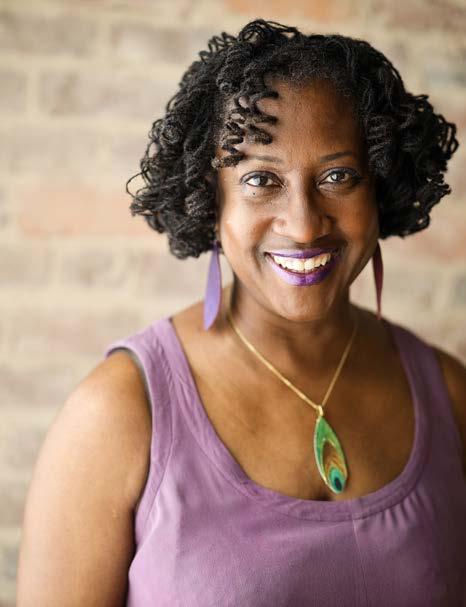
ON THE GO CREATIVITY in motion
HERE’S ONE WAY to get the creative juices flowing: Rose’s Inspiration Station. The mobile arts and crafts studio comes right to you, infusing imagination into kids’ birthday parties, weddings, and even work events.
Book online by selecting a predetermined theme—fantasy world, for example—or reach out with a one-of-a-kind idea of your own. On the day of the event, the whimsical wagon rolls up, brimming with creative materials to appeal to the traditional artist, paint, felt, and glue—or to the experimental one, battery-powered fairy lights, tiny plastic dinosaurs, and peacock feathers. Guests receive a project base and the freedom to choose from the materials on hand. When it’s
10 434 Metro
→
“I’ve seen my private students feel better about who they are as people over time. I realized I could encourage this same positive growth in a more intentional, and far-reaching capacity.”
BETH KAGARISE
SUPPLIED PHOTO
↓
Lisa Woolfork's popular podcast, "Stitch Please," centers Black voices in the sewing community.
all said and done, they walk away with finished crafts and an unforgettable experience of playfulness and positivity.
Inspiration Station is the creation of Rose Guterbock, award-winning figurative oil painter, self-taught silversmith, and neurodivergent mother of two. While her other endeavors felt worthwhile, creating art in her studio at the Shenandoah Valley Art Center and teaching traditional art techniques as a private instructor, Guterbock wanted to do more within the community. “I’ve seen my private students feel better about who they are as people over time,” she says. “I realized I could encourage this same positive growth in a more intentional, and far-reaching capacity.”
In addition to bringing the mobile studio to parties and events, Guterbock also partners with local businesses. She recently teamed up with Bluebird & Co. in Crozet, hosting wine and design events for adults and a regular art club for adolescents. She hopes to reach people where they are, fostering an inclusive atmosphere for imaginative thinking wherever she sets up shop.

Guterbock outfits the Inspiration Station with thoughtfully selected supplies, repurposing and upcycling as much as she can. The Scrappy Elephant is a go-to for like-new tools and other items. “Bringing unique and reclaimed creative materials helps our planet and keeps my prices affordable,” says Guterbock. “Every time you work with me, the materials on hand will be a little different. Embracing the unexpected can lead to some awe-inspiring creativity.”
With no doubt that art has positively impacted her life, Guterbock says her mission is to share that with as many people as she can. “Making art is healing. Making art connects us to one another. I hope that the individuals I work with will inspire others, passing the positive effects of creative expression on.”—Laura
Drummond
On the LIST
WITH THE VIRGINIA Festival of the Book already on our calendar (March 23-26), we reached out to Kalela Williams—the Center for the Book’s new director—to tell us what she’s most looking forward to reading from this year’s lineup. See her picks below, and visit vabook.org for the full festival schedule.—CH

Kaikeyi by Vaishnavi Patel
I love reimaginings, especially when authors revisit female characters. Kaikeyi is a queen from the ancient Hindu epic, though sadly, I’m not familiar with the Ramayana. Somehow I never learned a word about it in school or college. So getting to know the original text would be an education for me, and I’d love to see how Patel has reconsidered this figure.

Deaf Utopia: A Memoir—And a Love
Letter to a Way of Life by Nyle DiMarco
I’m really interested in stories that describe thriving in a world that isn’t built for everyone. That’s DiMarco in his memoir Deaf Utopia. His book is also an honoring of Deaf culture. Celebrations are always sweeter when they’re mothered by resilience.

How to Sell a Haunted House by Grady
 Hendrix
Hendrix
I started digging horror movies at the start of the pandemic, and now I’ve got the spine to creep into books, which are much more intimate and
lingering—basically, more terrifying. How to Sell has got the lift of humor, though, and you can’t scream all that much when you’re laughing.
Trailed: One Woman’s Quest to Solve the Shenandoah Murders by Kathryn
 Miles
Miles
True crime is my thing, and so is getting outdoors. Trailed chronicles a search to find out who killed a couple—two women who went camping together—so it might not seem like a nudge to get out there. But it’s a call that the wild should be safe for all of us. I mean, let me go hiking and just worry about bears, not murderers.
Inciting Joy by Ross Gay Ross Gay’s writing calls me back to a childhood at my grandmother’s house in Summerville, South Carolina, to the legions of flowers she spent hours tending, and how she carried on about each bloom. Her joy. Gay’s new book explores finding mine. Yours. All of ours. Yeah, that’s pretty special.

434 11 PAGE-TURNERS
Kaikeyi by Vaishnavi Patel
Deaf Utopia: A Memoir—And a Love Letter to a Way of Life by Nyle DiMarco
How to Sell a Haunted House by Grady Hendrix
Trailed: One Woman’s Quest to Solve the Shenandoah Murders by Kathryn Miles
SUPPLIED
Inciting Joy by Ross Gay
PHOTO
Kalela Williams
millions of Nigerian children spend hours each day walking To


Access to clean water is credited as the #1 reason for missed attendence at school, especially for Nigerian girls. We are committed to drilling at least one rural water well each year as part of our approach to helping the children of Nigeria regain their childhoods.

12 434
collecT clean waTer...
more and
Help is a 501 (c) (3)
Learn
donate at www.justhelpafrica.org Just
tax exempt nonprofit WE WaNT TO CHaNGE THaT
MEET Coach MOX
How Amaka Agugua-Hamilton broke barriers on her way to coaching UVA women’s basketball
 By Julia Stumbaugh
By Julia Stumbaugh
434 13 TRISTAN WILLIAMS
CONTINUED ON PAGE 14
CONTINUED FROM PAGE 13
When Amaka Agugua-Hamilton was growing up in Herndon, Virginia, she didn’t want to be a coach.
Long before she earned the nickname Coach Mox as an assistant coach at VCU, or recorded a historic inaugural season as head coach at Missouri State, or was named the sixth head coach of UVA’s women’s basketball in March, Agugua-Hamilton did not plan to be on the sidelines.
She wanted to be the first woman to play in the NBA.
Agugua-Hamilton saw herself in Charles Barkley, who muscled his way past players six inches taller to become one of the best rebounders in basketball history. At 5-foot-11-inches tall, she needed similar tenacity to earn a spot on a college roster. When she was accepted at Hofstra in the early 2000s, her dream—especially since the WNBA was founded—felt within reach.
Then, her knee gave out.
The injury sidelined her for the majority of her freshman season. She was considering transferring by the time Felisha Legette-Jack, now head coach at Syracuse, took over and shocked Agugua-Hamilton by naming her team captain as a sophomore.

“At first, I was like, ‘Are you sure? Me?’” says Agugua-Hamilton. “But she saw something in me, and it’s something that a lot of people had already brought to my attention, but I just didn’t really tap into it yet.”
Agugua-Hamilton’s injury troubles persisted throughout college. She fought through everything from stress fractures in her feet to sciatica in her back. One of her six knee surgeries forced Agugua-Hamilton to redshirt her senior year, so she spent it on the sidelines with the coaching staff.
“I started seeing how my teammates reacted to me,” says Agugua-Hamilton. “I got a lot of gratitude, and it filled me up, helping others and being a mentor to others. That’s where I started falling in love with coaching.”
Agugua-Hamilton received offers to play professionally overseas, but when her surgeon mother looked at scans of her daughter’s knees, she turned to Agu-
gua-Hamilton and warned her she had to stop playing basketball if she ever wanted to be able to play with her kids.
INTO THE THICK OF IT
After honing her leadership skills with assistant coaching jobs at VCU, Indiana, and Old Dominion, Agugua-Hamilton worked her way up to associate head coach at Michigan State.
Then, in early 2017, head coach Suzy Merchant fainted on the sidelines during a game and took time off to recover. Suddenly, Agugua-Hamilton was an interim Big Ten coach in charge of everything from game planning to radio interviews.
“My head was spinning for the first couple of weeks,” she says. “And then, I found a rhythm.”
This trial by fire ensured Agugua-Hamilton was ready two years later, when she was offered her first full-time head coaching position at Missouri State.
“People there told me, ‘You know, as a first-time head coach, it seems like this
isn’t your first rodeo,’” she says. “And I think it’s all because of those experiences I had at Michigan State, so I’m grateful for that. I’m also grateful that Suzy’s in better health.”
Merchant, who still coaches Michigan State today, recovered and was able to attend Agugua-Hamilton’s wedding that May, when Agugua-Hamilton tied the knot on a romance that, like her career, blossomed beside a basketball court. She met her husband, Billy, at the San Antonio Final Four, while she was an assistant coach at Indiana and he was an assistant at Savannah State. The two now have a son—and with every lingering twinge of old injuries, Agugua-Hamilton remembers how close she came to not meeting him.
As Agugua-Hamilton prepared her family to move to Springfield in 2019, she knew she was headed for more than just her first head coaching gig. She was also getting ready to be the first African American woman coach in Missouri State history.
↑
After a knee injury sidelined Amaka Agugua-Hamilton's dream of playing pro basketball, she turned to coaching. "I started to see how my teammates reacted to me," she says. "I got a lot of gratitude, and it filled me up, helping others and being a mentor."
14 434 Front & Center
TRISTAN WILLIAMS
Some would have seen it as pressure. She saw it as an opportunity.
Her 26-4 record in 2019-20 marked the best inaugural season by a head coach in the history of the Missouri Valley Conference. “I’m a believer and a God-fearing woman, and I truly believe I was called there,” says Agugua-Hamilton. “It’s a community that’s more of a conservative community, and maybe I was able to open some closed eyes.”
Despite the heartbreak of that first promising postseason being lost to COVID-19, Agugua-Hamilton returned to lead the Lady Bears to a 16-0 conference record and the NCAA Sweet 16 in 2020-21. She hopes her legacy will not be just that she broke racial barriers, but that she excelled at her job while doing so.
“At the end of the day, I do want to represent my community, and I want to make sure women of color have a platform and get more opportunities to get jobs, and to lead, and to help grow the next generation,” says Agugua-Hamilton.
“But at some point, I just want to be known as a great coach, no matter what my skin color is.”
COMING HOME
UVA athletic director Carla Williams was part of the coaching staff that took Georgia to two Final Fours and the 1996 NCAA championship, so she knows what a good coach looks like. And she knew she’d found one in Agugua-Hamilton during their first Zoom call.
“Coach Mox talked about academics first, and developing young ladies off the court first,” says Williams. “Once I realized how passionate she was about their lives outside of basketball, I already knew she was a great coach.”
When Williams extended the offer to coach at UVA, Agugua-Hamilton jumped at the chance to move her son and husband closer to extended family—and also to make the leap from mid-majors to the ACC.
It took her just two weeks to secure a high-profile commitment from Notre Dame transfer Sam Brunelle. After leading ACC freshman in scoring in 2019-20, Brunelle’s next two seasons were cut short by injuries, the last of which required intensive surgery last summer. Agugua-Hamilton and her staff have helped Brunelle through the agonizing process of relearning how to use her healing shoulder.
“I’m one of those coaches that holds kids out a little bit to make sure that they’re prepared to come back physically, but also mentally,” says Agugua-Hamilton. “Coming back from injuries is really taxing on the mental side, and that sometimes is overlooked.”
This guidance is part of why Brunelle, who first met Agugua-Hamilton as the former No. 1 overall high school recruit out of Greene County’s William Monroe High School, says Virginia’s new coach played a major role in her transfer decision. “Coach Mox has been through it as
well, with her knee injuries, and she really understands where I’m coming from with the adversity I’ve had to face,” says Brunelle. “It’s really nice to have someone who understands that in the forefront of helping you with rehab.”
Last year, Virginia women’s basketball missed the NCAA tournament for the fourth straight year after winning just five of 27 games.
That’s not the UVA Agugua-Hamilton remembers while watching coach Debbie Ryan and Dawn Staley, Wendy Palmer, and Tammi Reiss play in orange and navy blue.
“I understand the program kind of went on a downward spiral the last couple of years, but my vision of this program is the Final Fours, the Elite Eights, because that’s what I grew up knowing about UVA,” says Agugua-Hamilton.
The first thing she wanted to do to jolt the Cavaliers out of this spiral was change the team culture, which she found was easier than expected. “I think I was a little bit surprised with how hard we work, and how competitive we have been from day one of getting on the court with them,” says Agugua-Hamilton. “I thought that was going to be something that I was going to have to change a little bit, just based on last year. But our kids want to win, and they work hard.”
With family culture in place, Agugua-Hamilton can focus on emphasizing her players’ versatility and athleticism with up-tempo basketball. Alongside the bulk of her Missouri State coaching staff, she pushes her seven returnees, two transfers, and two first-years through energetic practices.
Shooters rotate briskly around the floor. Defensive drills are frenetic. Agugua-Hamilton is readying her players to push the ball.
Whenever Williams stops by practice, she sees joy in everyone’s face, even through the pain. “We’ve got a long way to go, but we’ve come a long way,” says Williams. “I think that she is exactly what college athletics, women’s basketball, and UVA athletics needs, and that’s a coach who cares about the student athlete outside of their sport and is truly invested in their development as people.”

434 15
This story originally ran in C-VILLE Weekly.
“My vision of this program is the Final Fours, the Elite Eights, because that’s what I grew up knowing about UVA.”
COACH MOX
“Great to have a family owned jeweler that you can trust with fair pricing and answers to your questions.”
“ I bought an engagement ring there last Spring. Andy was a pleasure to work with and took the time to help me make sure I made the right purchase. I had visited several other jewelers and there was a huge difference in customer service. I would recommend the store for any jewelry purchase without hesitation.”
FIRST PLACE: Best Wedding Jewelry Cville Weekly, Best of Cville, past winner
FIRST PLACE: Best Jewelry Store Cville Weekly, Best of Cville, past winner

16 434
andrewmintonjewelers.com | 434-979-7672 | Seminole Square Shopping Center
Pump, pump, PASS
Share the Drop makes breast milk more accessible
By Maeve Hayden
How do we feed our babies? It’s a question Kelly Cox has been fielding from new parents for over a decade.
Cox, a licensed clinical social worker, registered prenatal yoga teacher, and birth doula, has hands-on experience helping moms through every stage of pregnancy. After six years of working as a therapist with mainly domestic violence sexual assault victims in Charlottesville, Cox went on to open Bend Yoga in 2010. The studio specialized in children’s and pre- and post-natal yoga, and held free weekly lactation support groups until its closing in 2020.
It was during those 10 years running Bend that Cox became aware of one of the biggest stressors new moms experience: breastfeeding.
Breastfeeding is no easy feat, and every mom’s experience is different. “Some women have an amazing time feeding, and they produce more than their babies can even use,” says Cox. “What I saw more of was mothers who, for some reason, couldn’t produce milk.” Going on medications for medical issues or for mental health, stress, and even returning to work can affect a nursing mother’s milk supply, according to Cox.
Cox would help connect moms with a surplus of breast milk with people in need of the liquid gold. She would also direct people to a number of milk sharing groups on Facebook, but she found the search process to be clunky and cumbersome.
Then one night, inspiration struck from the most unlikely of places.
“I was emailing two clients late one evening. One of them had milk she needed to get rid of before she moved, and one of them had just been diagnosed with breast cancer and knew that she
couldn’t produce. As I was emailing them to introduce them, a notification went off on my phone from Bumble saying that I had matched with someone,” says Cox. “If we can go on our phones and order a car, and rent a stranger’s house, if I can meet my perfect match, why couldn’t families use this?”
Cox and her business partner, Celia Castleman, decided to make this idea a reality when COVID struck. The two started working with Shockoe, a Richmond-based app development firm, to create Share the Drop, a free app that connects milk donors with recipients. The development process was made even more urgent when Abbott, a baby formula manufacturer, issued a recall of several formula products, resulting in a nationwide formula shortage.

Share the Drop offers a streamlined search process for anyone in need of breast milk, and it’s completely free to use—no download or registration fees.
To use Share the Drop, users have to agree to follow Eats on Feets four pillars of safe breast milk sharing: informed choice, donor screening, safe handling, and home pasteurization. Recipients can then search for milk donors by distance, age, and other specific criteria, including dietary restrictions and allergies, and donors can upload recent test results for an added level of safety.
Though the FDA and the American Academy of Pediatrics warn about risks associated with informal breast milk sharing, Cox says Share the Drop is a tool that families can decide to use for themselves. “It’s all based on informed consent,” she says.
Currently, Share the Drop can be accessed through the Google Play store, or through sharethedrop.com. Cox says many families who can’t afford breast milk use the service, in addition to samesex couples and breast cancer survivors.
“I am a breast cancer survivor, and I’ve made it my mission locally to make sure that any other woman who has lost all of her mammary glands is able to find human milk if they need it.”
Cox and Castleman are still waiting on approval from Apple’s app store, which they hope to receive soon.
“I don’t think the formula crisis is going to end anytime soon,” Cox says, “so we are just really trying to get the word out about this resource.”
434 17 Front & Center
↑
Clinical social worker and doula Kelly Cox (left) saw a hole in the market for breast milk. Now, with her business partner Celia Castleman, she’s connecting breast milk to parents in need through her app, Share the Drop.
EZE AMOS

Front & Center
The artist’s ARTIST
Jen Deibert just loves to make things
By Carol Diggs
Jen Deibert doesn’t care much for categories. “I would not call myself a potter,” she says, although her cozy cluttered studio is packed with ceramic pieces. (It actually looks like a vintage shoppe and a crystals booth got married in a kiln and had children.) Asked about her art, Deibert simply says, “I make things.” But whatever she’s creating, she clearly has The Touch, because people love her work.

Deibert starting creating early: “I always loved rocks and crystals and digging in the dirt.” By the time her family moved to Charlottesville in her middle-school years, she recalls, “I was making my own necklaces and earrings. My parents loved to go to antique shopping—they’d take me along, and I would get these great vintage jewelry pieces and take them apart to make new things. And the girls at school would say, ‘Could you make me something?’ I would decorate my notebook covers, and people would say, ‘Where did you get that?’”
Next, Deibert says, she taught herself how to make stained glass, and sold it on the Downtown Mall. She left college because she couldn’t decide on a major; she got a real estate license, but all she really wanted to do was make things. She has no formal art training: “I never liked sitting still or following directions,” Deibert says with characteristic candor. She kept on doing what she loved: finding and using vintage jewelry, clothing, and objects to make new things in her own eclectic style. But she found the distinction people made between her work as “craft,” and the more valid, respectable “art” to be a false one. “It’s taken me 45 years to say I’m an artist,” she says.
Two years ago, Deibert began developing her own approach to ceramics. She had bought a cheap potter’s wheel to try out (“I hated it—it’s now a spider house”),
but she found working with clay and hand-building felt really familiar. “Working with the earth [...] there are endless possibilities. There’s nothing you can’t make from clay.”
And to prove it, Deibert’s current and most popular creations are trophies—recognition of achievements which have nothing to do with competition. Her trophies are child-like, homemade, painted in gleaming white and bright colors, each one unique and proudly displaying affirmative or thought-provoking mantras: “Keep going.” “You’re doing great.” “Good job floating through space.” “Is any of this even real?” “Oh dear, what a year!” Even, “We’re going to need a better trophy.”
Deibert says her ideas start from a phrase. “My [work] is more about the message, but in a physical thing you can touch,” she says. “It’s more about the things I’m trying to get people to think about.” Many of these ideas come to Deibert while she is meditating under a special lamp called a Lucia No. 3. She has one mounted over the couch/bed in her studio; she characterizes its impact as “like a more modern version of staring into the flames. It’s a tool for creativity.”
Deibert works on other objects as well. Scattered around her studio are ceramic cups, vases, and animals as well as vintage objects modified with crystals, paint, clay, and papier-mache. (A favorite example: a table lamp modified
into a bright yellow banana decorated with quartz prisms and one staring bright blue eye, emblazoned with “Don’t forget we are here to have fun!” around the shade.) Her works are available for sale on her Facebook and Instagram pages and at The Quirk Gallery.
While she’s enthusiastic about her ceramic work, Deibert also wants to continue working with jewelry and vintage clothing. “I have this mental list of all the things I want to make,” she says. “When I get old, I want to have all these things [around me] that were made by me.” Which is a wonderful description of the Deibert home in Esmont, where Jen, husband Josh, 8-year-old daughter Birdie (“already a wonderful artist,” says her proud mother), and their five dogs have lived since 2017. The large farmhouse has a charmingly overgrown Secret Garden atmosphere. Her studio in the vine-draped English basement has a worktable watched over by a turquoise papier-mache dolphin, a plastic chair the shape of a giant cupped hand, and the Lucia meditation bed under a parachute canopy.
Whether it’s vintage jewelry, a second-hand lamp, or a 1950s housedress, “I just like recycling old things,” Deibert says. “I love pointing out or finding things other people ignore. They are begging you to look at them. We all want to be validated.”

434 19
↑ Self-taught artist Jen Deibert's quirky handmade trophies celebrate (and champion) the little things.
EZE AMOS
EZE AMOS
An ARTIST’S perspective
Lincoln Perry’s new book offers ways to make art less intimidating
By Sarah Sargent
Lincoln Perry has been a prominent figure on the Charlottesville art scene since the mid-1980s. An acclaimed muralist with significant work in landscapes, figurative paintings, and sculpture, Perry’s murals grace walls around the country including the Met Life building in St.

Louis and at the University of Virginia. “The Student’s Progress,” in UVA’s Old Cabell Hall, follows the journey of a fictional student named Shannon from her undergraduate days into her adulthood when she becomes a professor at the university. Consisting of 29 panels, the piece took 16 years to complete.
Perry first visited Charlottesville in 1970, and returned 15 years later to fill in for Philip Geiger, teaching drawing for a semester at UVA. It was during this time that he met his wife, author Ann Beattie, who was also teaching at UVA. After about a decade, the couple left Charlottesville, but returned in 2001. Both held teaching positions until 2012. They now divide time between Maine, Virginia, and Florida.
We caught up with Perry in Maine, where he was fresh off an interview with the local NPR affiliate, to talk about his
new book, Seeing Like an Artist: What Artists Perceive in the Art of Others
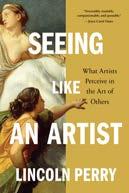
434: I think of you as a painter. Have you always written?
Lincoln Perry: No, in fact, I just came across a notebook I kept in 1981 that’s really badly written. So, somewhere along the line, I think maybe from living with Ann, I must have improved.
I was struck by the quality of your writing. There are numerous beautifully written paragraphs—I loved, in particular, your descriptions of the Bruegels. I also liked the way you integrated modern references and popular culture into your writing, it struck me as akin to what you did with paint in the Cabell Hall mural.
That’s actually interesting. I hadn’t even thought of that.
I would think your narrative talent would serve you well helping you conceive of murals.
Yes. I wish I could do more of them. The hard part is getting the job. I was just a finalist for a courthouse in Alabama. It would have been fun. I enjoy the external collaboration of projects like that.
Are you continuing to write, and if so, how do you balance that with artmaking?
I can only paint for so long and I can only sculpt for so long, or draw for so long. Writing is a way to fill in the chinks between those other bricks. I love the way the little sketches included in the book make us see the art through your eyes and pay attention to what you are looking at. Some part of me thought I should make them more diagrammatic, but then I decided that doesn’t do justice to the things, so, I did my best to do copies.
What are you looking for when you look at art?
The book was originally going to be called Stealing from Museums, but the trouble was they thought it would be put in the crime section. But that’s really what it’s about—how painters and potentially non-painters learn to see in different ways. I think a lot of people are intimidated by visual art; they think there’s something they’re supposed to
20 434
Front & Center
↑ Artist Lincoln Perry’s book of essays offers new ways to look at and appreciate art.
SUPPLIED PHOTO
be getting. It’s a visual experience first. Let it wash over you and take pleasure in it. The idea is not to be intimidated or exhausted. It’s best to see some things well as opposed to trying to see everything. When I first went to Italy, I had one of the Blue Guides and I thought, because it was in the book, I had to go see it, and it became insane. Eventually, I realized that you can get more out of less.
I didn’t realize, until I read the book, that you sculpted. Is that something you’ve always done?
That started about 30 years ago. Difficulty interests me. Making a sculpture that’s legible and enticing from 360 degrees as opposed to, say, one view or two views is really difficult. About three years ago I started carving marble, which is ridiculously difficult. It’s al-
most too much: I feel like, c’mon, I’m too old for this. The stuff weighs a ton and is hard as a rock. But it does make me realize I spend at least as much time in museums looking at sculpture as I do paintings. They have to be seen in the round and, as I say in the book, you really have to be there in “the presence of” in order to read them properly. Which is also true of paintings, more than people know.
Describe a dream art-viewing trip. A dream trip would be returning to the Villa Valmarana ai Nani in Vicenza, Italy, to see the Tiepolo frescoes. I also want to see Naples again because of the museums there.


As a successful creative person married to a successful creative person, how do you give equal
opportunity to your respective practices?
Well, I read everything she writes, but not until she feels it’s done. It’s harder for me to lure her into the studio. She has a very good eye, but she’s really more interested in photography; she takes beautiful photographs—I think she should publish them. Painting’s a little mysterious to her and she wishes I wouldn’t carve marble because I’m getting old and I’ve got arthritis and she wonders what I’m doing this for. I totally respect what she does. I enjoy writing these essays but I cannot imagine writing fiction, and she can’t imagine painting. I suppose there are happy marriages among two painters or two writers, but in our case, it works well that we’re in different fields.
434 21
This story originally ran in C-VILLE Weekly.
SUPPLIED PHOTOS
↑
In his book, Lincoln Perry utilizes renderings of classic paintings to help readers understand how best to view art.

22 434


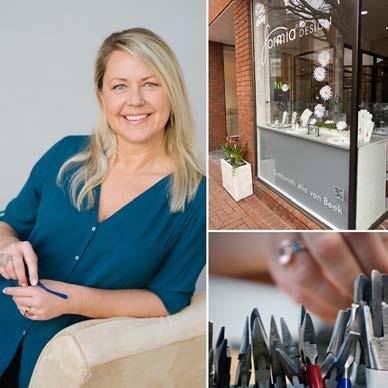

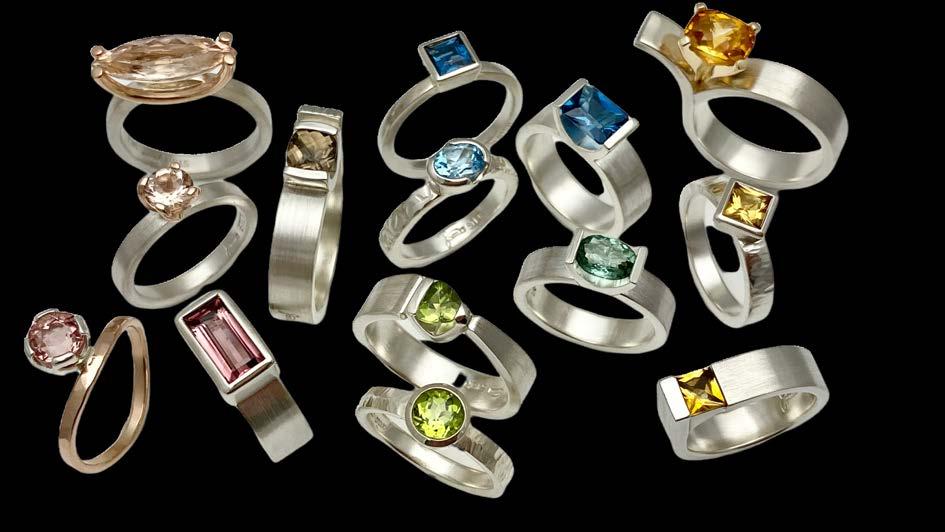

Local Handmade Jewelry •Limited edition •Custom jewelry designed by your own kids! •Jewelry repairs formiadesign.com 420 e. main st. charlottesville, va 22902 434-981-8389 info@formiadesign.com formiadesign.com 420 e.mainst. harlottesville,va 434-981-8389 info@formiadesign.com DESIGN Goldsmith Mia van Beek Goldsmith Mia van Beek Sophisticated. Trendsetting. Fearless. Simple. Mia van Beek, Owner & Goldsmith
Ten years in
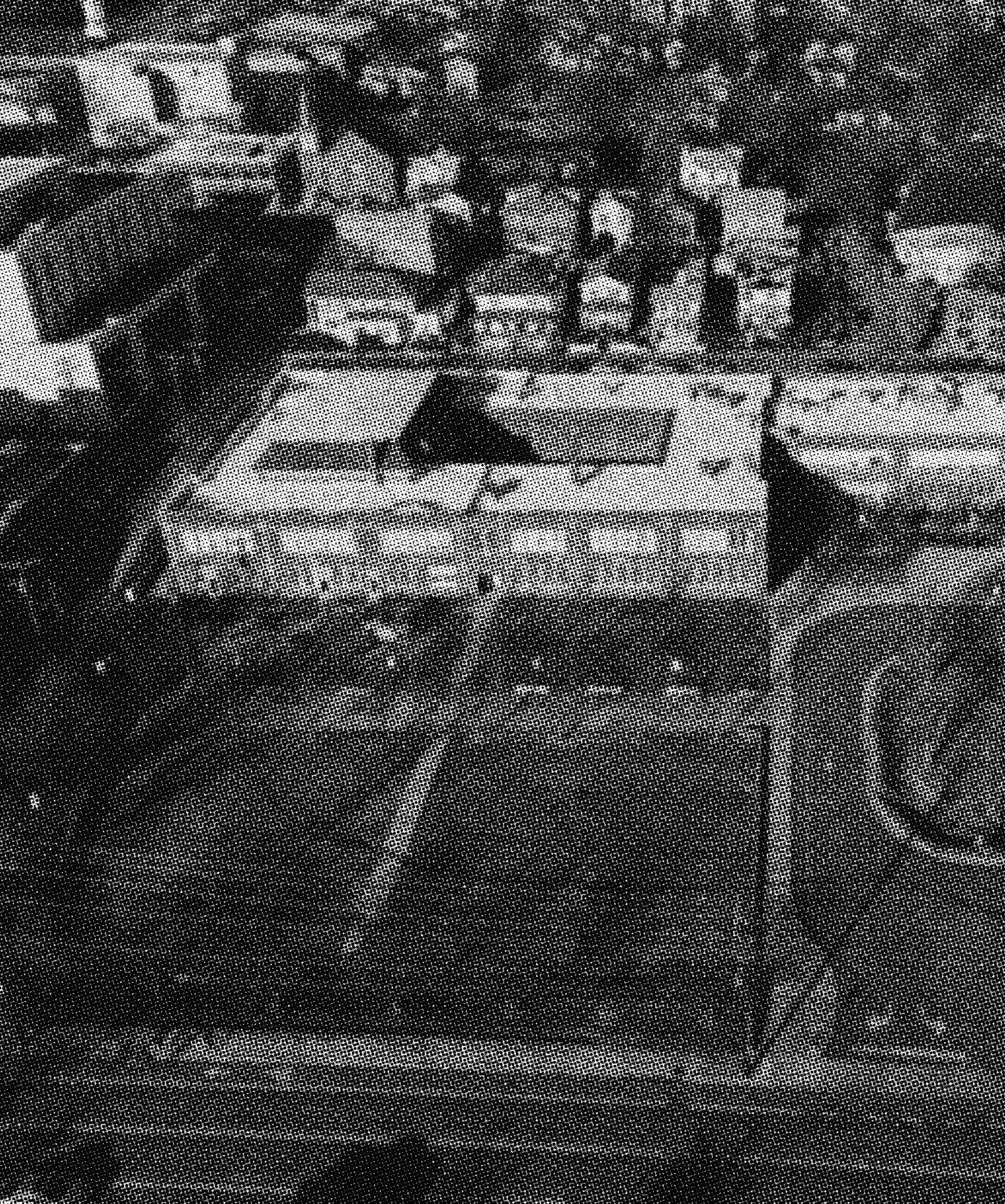 By Carol Diggs
By Carol Diggs


24 434
his year, the Jefferson School African American Heritage Center marks its 10th anniversary. Since 2013, it has provided educational programs, cultural events, and commemorations for Charlottesville’s Black community—and revived the role of the original Jefferson School.

“From its founding, the Jefferson School held the cultural practices—the gatherings, performances, the festivals—of the African American Community,” says Andrea Douglas, who has been executive director of JSAAHC since its founding. “The Center came [into being] to connect the history of that institution to the modern space.”

PART OF OUR CITY'S PAST
Following emancipation, Charlottesville’s Black community began creating the institutions it had long been denied. One of the first was the Jefferson School, a Freedmen’s Bureau school offering both elementary education and teacher training. The school was opened in 1865, in the building at Seventh and Main streets shared with the First Baptist Church, one of the city’s first independent Black congregations.
Thirty years later, the Jefferson Graded School (for grades one through eight) moved into its own building at Commerce and Fourth streets in Starr Hill. But under Jim Crow, there was no requirement for Charlottesville to provide a high school for Black students. It wasn’t until 1926, after the African American community petitioned City Council, that the first Black high school in Charlottesville opened in a new building (the one that is now the home of the JSAAHC), constructed adjacent to the Jefferson Graded School.

For the next 25 years, the Jefferson School (by this point grades one through 12) was home to a wide range of activities—from athletic teams and clubs to music and theater groups—that supported the culture and cohesiveness of the Black community. Its auditorium hosted school and public events at a time when venues like the Jefferson Theater and the Paramount, while open to Blacks, were restricted spaces. In 1934, the city opened
CONTINUED ON PAGE 26
434 25
years
Providing place and space for Charlottesville’s Black community
CONTINUED FROM PAGE 25
a Colored Branch library in the school; municipal libraries were segregated until 1948.
In 1951, to accommodate the city’s growing African American population, Burley High School was built for Black students; the Jefferson School continued to teach Black students in grades one through eight. Seven years later, after Brown v. Board of Education, the Charlottesville 12 (Black students from Jefferson and Burley) petitioned to attend white schools, and forced the city’s schools to integrate.
While the city grappled with how to integrate its existing schools, the Jefferson School offered grades seven and eight for Black students. In 1966, when integration was finalized, the Jefferson School taught sixth grade for both white and Black students—a first in the city’s history. But, as Douglas points out, “When the school [stopped being] an all-Black institution, you ended that [community] space. What we’re trying to do is redress that loss of the cultural practices of Charlottesville’s African American community.”
“It’s really important and unusual that we have in our community a descendant organization of the original Freedmen’s School,” says Jalane Schmidt, a UVA professor and director of the Memory Project at the UVA Karsh Institute of Democracy. “It’s a direct link to the community’s Reconstruction history.”
REINVENTING THE JEFFERSON SCHOOL’S ROLE

In 2002, a group of Jefferson School alumni, Starr Hill residents, and figures from local businesses, government, and nonprofits began talking about restoring the Jefferson School as a mixed-use community center. In 2006, the school building was added to the National Register of Historic Places; in 2013, it reopened as the Jefferson School City Center, housing a range of community services and the newly formed Jefferson School African American Heritage Center.
“We think of ourselves as a bridge from history out,” says Douglas. “We’re not a museum. We’re an event-driven cultural space, a place to celebrate the arts, the festivals, the gatherings—a place where the Black community feels at home.”
But Douglas emphasizes that JSAAHC is a resource for the wider community as well. “Our mission is not ‘We just do things for Black people.’ White people need our programming as much or more than Blacks do—we know our history.”
SUPPORTING THE BLACK COMMUNITY
To fulfill that mission, JSAAHC’s programming over the last 10 years has been wide-ranging. Its permanent exhibition, “Pride Overcomes Prejudice,” tells the history of the local Black com-
EZE
AMOS
munity from emancipation through the late 20th century, often through the voices of Jefferson School alumni and community members. Rotating exhibits focus on community history and on the works of contemporary Black/diaspora artists.
JSAAHC’s Isabella Gibbons Local History Center, named for the Jefferson School’s first Black teacher, offers resources for researching family and area history. In 2017, local journalist and social historian Jordy Yager worked with JSAAHC and others to launch the African American Oral History Project. Now at JSAAHC, Yager’s current undertaking, called Mapping Cville, documents Black land ownership and racist housing policies in Charlottesville and Albemarle County; its findings will be hosted online for use by researchers and local schools.
The center also provides space for community meetings, presentations, guest speakers, and activities ranging from Kwanzaa and Juneteenth celebrations to book discussions and the annual Greens Cook Off. The former school auditorium now hosts the Charlottesville Players Guild, a reincarnation of a Black troupe that performed there in the 1950s; the Players Guild presents a full range of productions, from Shakespeare to contemporary Black/diaspora theater.
DRIVING CHANGE
In addition to promoting Black history and culture, JSAAHC was intended to be a forum for addressing racial inequities past and present. “We believe what we do should help drive cultural change,” Douglas says. “This city is not this city without the truth and authenticity of fact.”
To that end, Douglas served on the Blue Ribbon Commission for Race, Memorials and Public Spaces, which met at JSAAHC in 2016. In the 2017 lead-up to the Unite the Right rally, City
Council asked the center to host response planning and preparations. “We had 400 people here to be educated about the Proud Boys, and why it was important to be on the streets that day,” says Douglas. “This is the place that Charlottesville came to understand what was happening and why.”
When the statue of Robert E. Lee was finally taken down in 2021, JSAAHC led the development of Swords Into Plowshares, a project to re-use the statue’s bronze to create an artwork symbolizing the city’s commitment to racial inclusivity and healing.
But telling the city’s Black history encompasses far more than contextualizing the stat-
ues. JSAAHC has developed a Black history walking tour of the city, from the Court Square slave auction block to the Daughters of Zion Cemetery; worked with area schools to help teachers incorporate local Black history into their curricula; and advocated for March 3 (the day Union soldiers arrived in Charlottesville in 1865) as Freedom and Liberation Day. The Center helped locate and memorialize the site where John Henry James was lynched in 1898—and raised the money to take 100 people to the National Memorial for Peace and Justice in Montgomery, Alabama, to deliver soil from where James was killed.
“JSAAHC plays a singular role of promoting and hosting the very difficult discussions about race and justice,” says Schmidt, who as an activist and public historian has worked on many of JSAAHC’s public education programs. “The public knows that the center holds a place for these discussions—and it’s trusted by the community at large.”
THE WORK CONTINUES
JSAAHC marked its 10th anniversary in January with a social event—and two days later held a facilitated discussion on race, politics, and the Black community. The Players Guild performances and exhibitions highlighting Black artists; the ongoing work of Swords Into Plowshares and Mapping Cville; Trailblazers, a program that trains African American youth to be community guides; the 2023 Civil Rights Bus Tour with the Memory Project—the center’s commitment to convene, educate, support, and lead continues.
“The Jefferson School, and now the Heritage Center, was and is a touchstone for the African American community,” says Douglas. “We have taken the idea of Blackness in Charlottesville and made it tangible.”
August Wilson’s Century Cycle comes full circle

Perhaps no one has presented the African American experience with more perception, passion, and depth than Pulitzer Prize-winning playwright August Wilson. In 2017, the Charlottesville Players Guild, under the leadership of Artistic Director and writer/director/actor Leslie M. Scott-Jones, staged Wilson’s Fences, and launched the troupe’s commitment to stage the playwright’s complete American Century Cycle—10 plays examining the changes and challenges affecting Black Americans in each decade of the 20th century. Only a handful of theater companies in the nation have taken on this challenge.
In 2023, the guild will complete the cycle with productions of Seven Guitars, based in the 1940s (February 23-March 5); Ma Rainey’s Black Bottom, covering the 1920s (June 15-25); and King Hedley II, set in the 1980s (October 12-22). The week following the cycle’s completion, the JSAAHC will host “Wilsonian Soldiers,” a five-day symposium with panel discussions and master classes from four noted national Black theater practitioners and several local theater artists. The symposium will culminate in a performance of How I Learned What I Learned, Wilson’s theatrical memoir. Visit jeffschoolheritagecenter.org for tickets and season subscription information.

434 27
RICH SUGG
EZE AMOS
Jefferson School African American Heritage Center Executive Director Andrea Douglas underscores its importance for the Charlottesville community: "We’re not a museum," she says. "We’re an event-driven cultural space, a place to celebrate the arts, the festivals, the gatherings—a place where the Black community feels at home."
Playwright August Wilson
Wine Shop Wine Bar Guild Membership

The Guild is open to the public and offers membership for all wine lovers!

Members enjoy 20% off and have access to private tastings with winemakers, wine dinners, local vineyard tours, and much more.




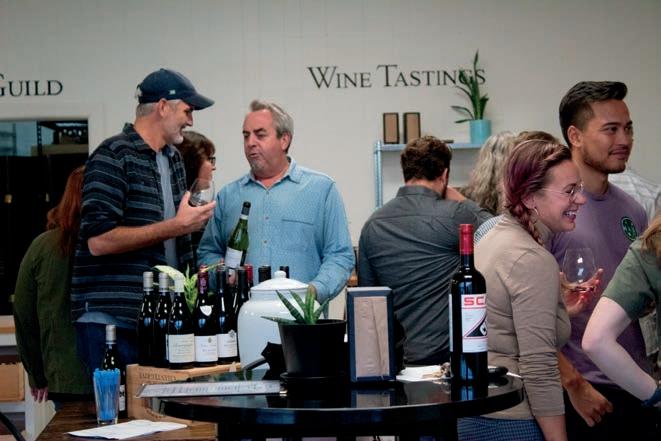

Visit us at our new location! 600 Concord Ave. Suite 2 434.202.4332 www.wineguildcville.com wineguildofcharlottesville wineguildcville Free tastings every Wednesday 5:30 - 7:30pm
For a good day, call...

I start the day with a long walk at Foxhaven Farm with my husband Seth and our dog, Beanz. It’s a gorgeous day and everything is beginning to bloom. Afterward, breakfast from Petite MarieBette is in order: egg and Gruyère on five-grain sourdough, paired with a latte. I spend the rest of the morning writing in my office on the Downtown Mall, where I can hear buskers warming up outside my windows. In an inspirational reminder, I spy John Grisham heading to Petit Pois for a lunch date. I head out to Beer Run for my own lunch date, meeting a friend to share a plate of the best nachos. The walk back to my office is peppered with sightings of friends and acquaintances; a hug here, a smile and greeting there. It’s so nice to see everyone! In the afternoon, I do a bit of sustainable shopping at Natalie Dressed where I score a stylish, gently used dress that fits perfectly. It’s the first Friday of the month, so I go to Friday Night Writes at New Dominion Bookshop to listen to locals read their work. Will I read something, too? Sure, I will! And after, everyone will applaud. Later, wearing my new-to-me dress, I join my husband for a cocktail at tavola’s cicchetti bar followed by a delicious dinner of burrata and eggplant Parmesan. Am I dreaming? No, it’s just another perfect day in Charlottesville.
Marijean OLDHAM President, Jaggers Communications

30 434
TRISTAN WILLIAMS


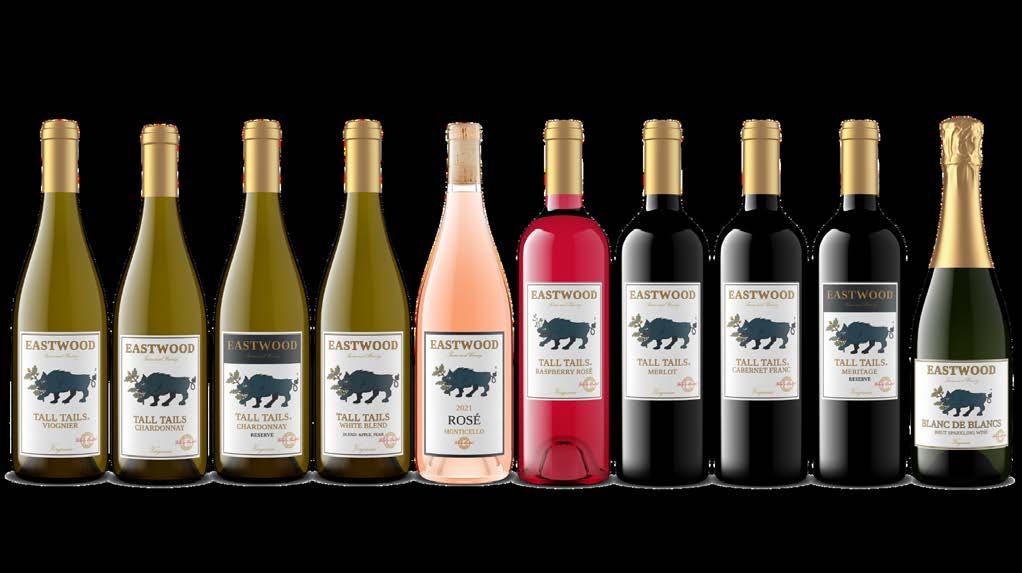

IT'S YOUR WINE eastwoodfarmandwinery.com #followtheblueboar DON'T KEEP IT BOTTLED UP WINNER
Supercharge your business with Ting Internet
Our lightning-fast fiber internet is designed to help you grow your small business. Ting Internet offers download and upload speeds of up to 1,000 Mbps, giving you instant data transfers and seamless video conferencing.



Our fiber network is far more reliable and secure than cable, which means you can spend more time with your customers and less with customer support. Supercharge your business with Ting Internet, starting at just $139 a month.
Sign up for Ting Internet and get a $300 account credit along with free standard installation. Learn more at tinginternet.com/smallbusiness.









































 Hendrix
Hendrix
 Miles
Miles




 By Julia Stumbaugh
By Julia Stumbaugh


















 By Carol Diggs
By Carol Diggs






















